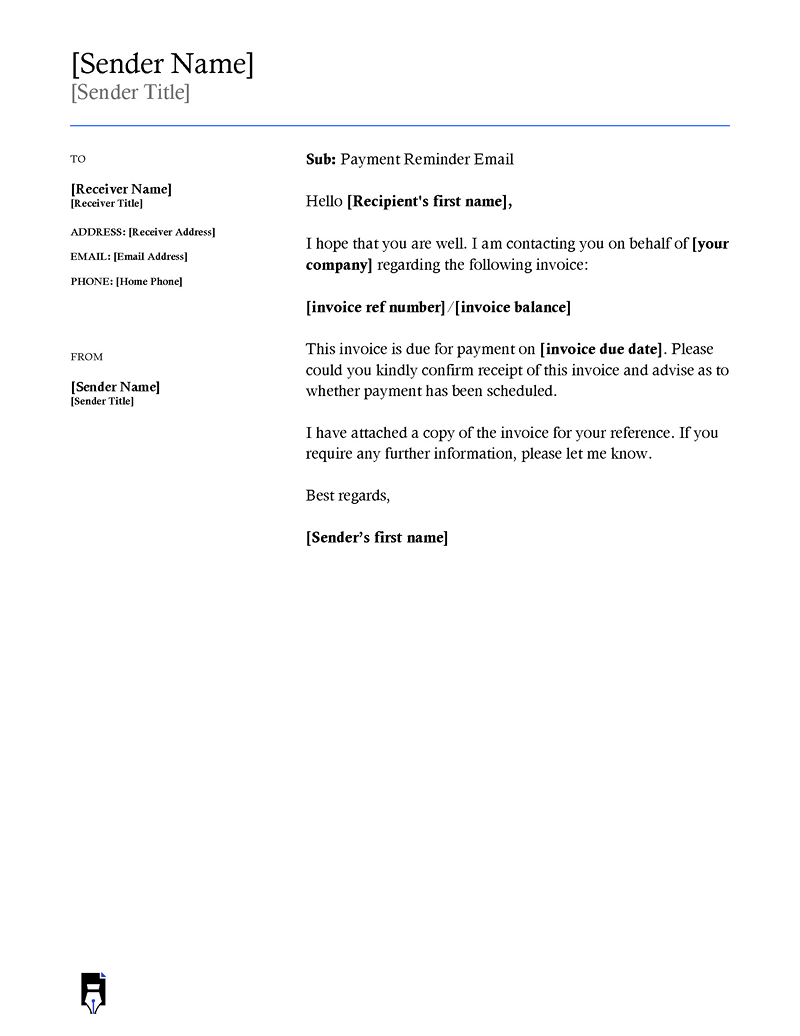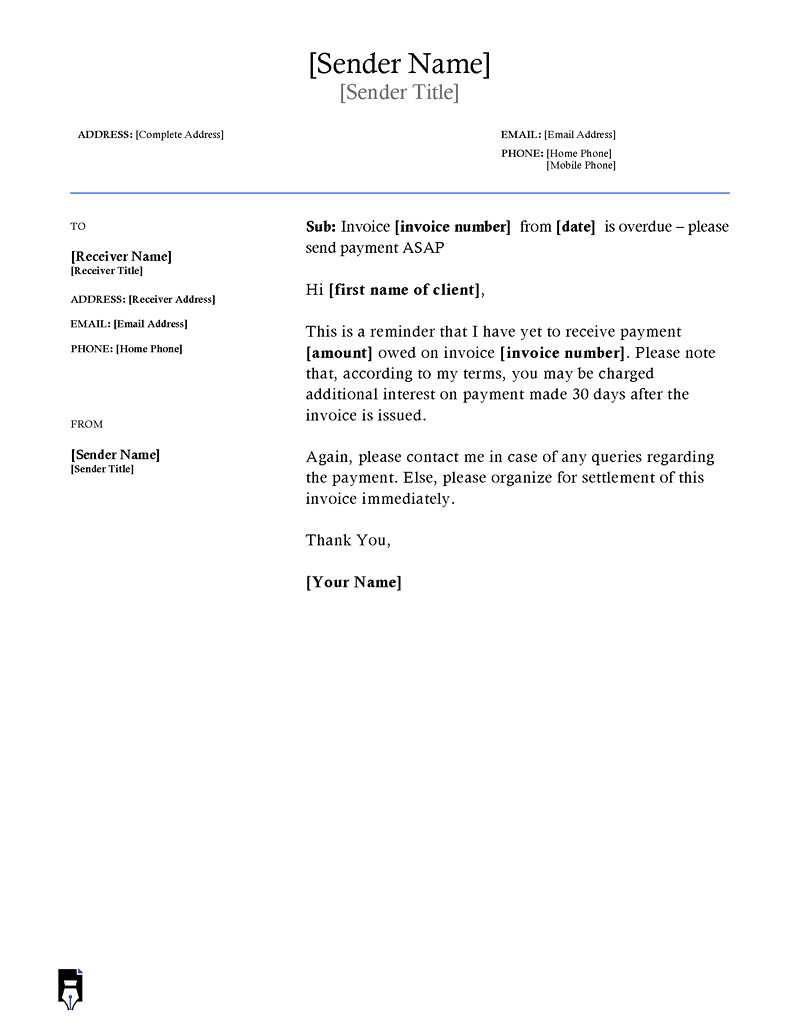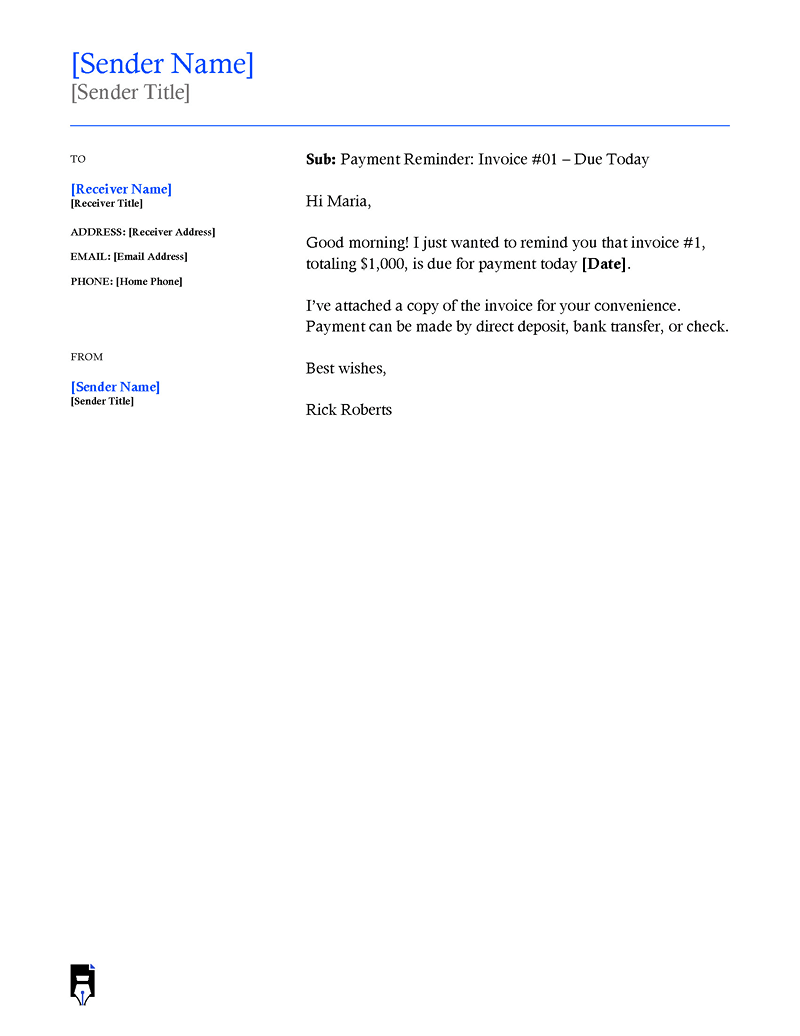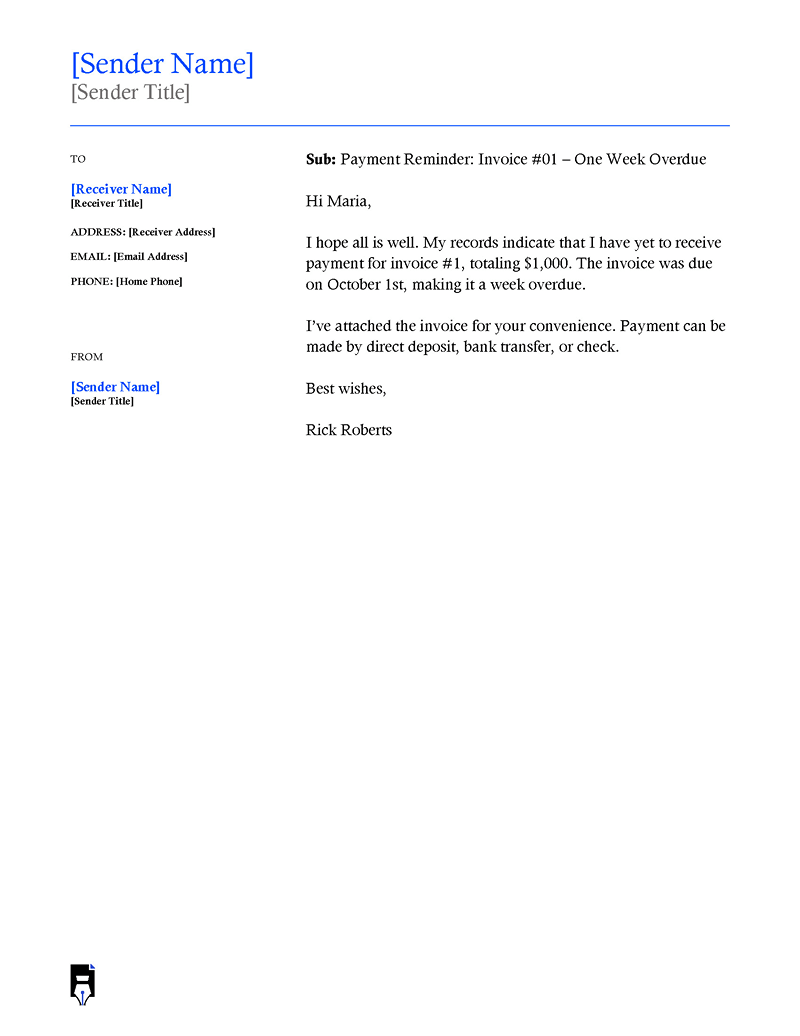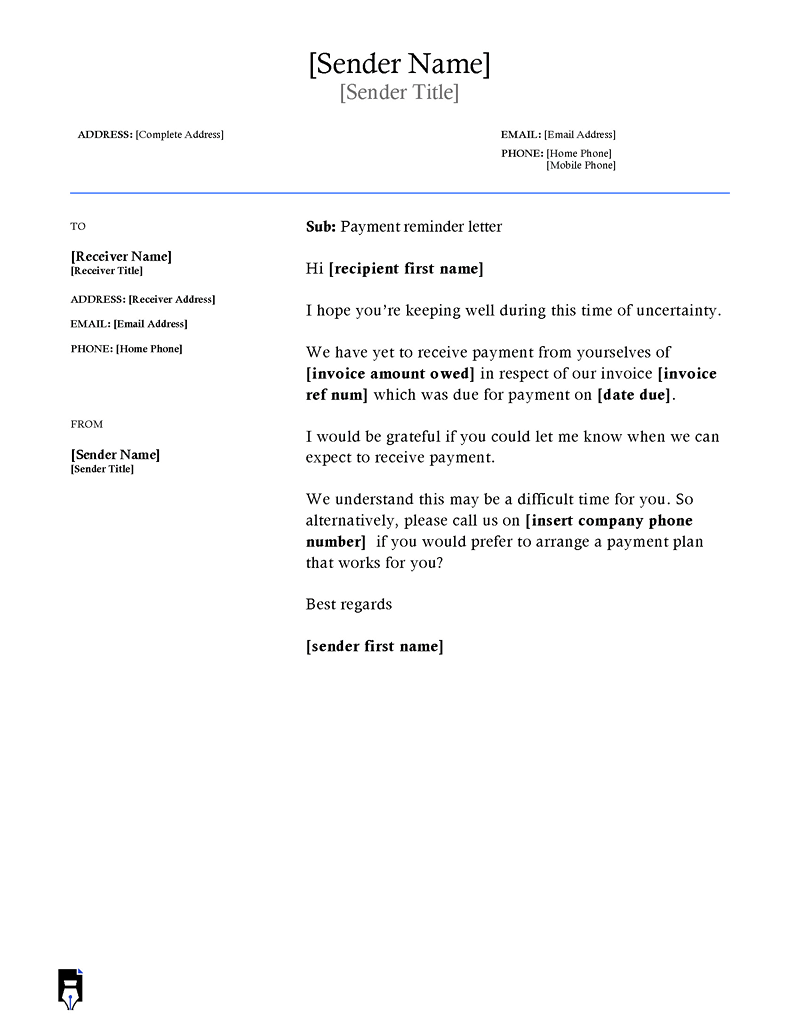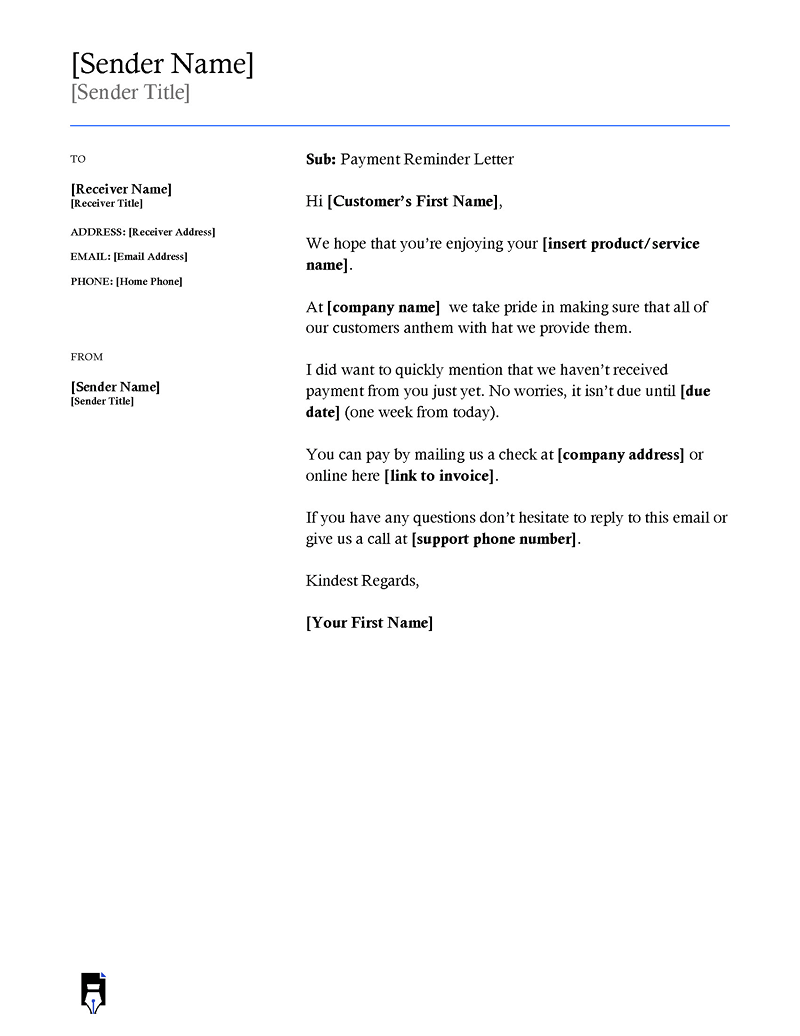A payment reminder is a formal message you send to your customers via email to remind them that they have an overdue balance on their account.
This comes in addition to the regular billing emails you might send and is typically sent after several days or weeks past the due date.
General Overview
You will, from time to time, have customers who are reluctant to pay their bills for one reason or the other. Payment delays affect your business’s cash flow. This can lead to other challenges, such as insufficient funds for daily operations. As a result, you have to pursue outstanding payments through different methods, such as reminder emails.
Emails are a popular approach as they are more convenient than verbal communication. This is because emails can be automated so that reminders can be sent immediately after a payment passes its due date. This consequently tracks debt payments while eliminating the frustration of contacting clients directly.
The payment reminder is a formal correspondence and should be treated as such. Despite the inconvenience caused by unpaid invoices, you should work to preserve your relationship with customers when collecting debts. Be polite but precise, firm, and persistent. The email should indicate the amount owed, the original due date, applicable interest, and the consequences of non-payment.
Other names used to refer to this type of email are:
- Payment reminder letter
- Overdue payment letter
- Late payment letter
- First debt recovery letter
This article will elaborate on preparing an effective late payment reminder email and provide pre-made templates for you to use as guides. Also, when sending an email, customers can fall behind on payments for diverse reasons, such as not receiving or seeing the billing email, using the wrong email address, and forgetting or preferring physical invoices. Therefore, ensure to maintain a professional attitude.
Also, guide the customers on the actions they should take to settle their accounts.
Payment Reminder Templates
Templates can be a huge help when drafting a late payment email. They outline what should be in the message and help ensure you do not forget anything. This saves the users the time and effort of creating a reminder email from scratch. Our website lets readers download free pre-made templates for payment reminder letters or emails.
When to Send Payment Reminder Email
By sending an email payment reminder, you will hopefully cause your customers to take action and pay their overdue balances for past services rendered rather than ignore the invoices and accumulate interest over time. So, how often should you send reminder emails? First, you should plan the schedule and sequence you will use to remind clients to pay any outstanding balances.
One of the benefits of using payment reminders is that they reduce the time you spend chasing late payments. This is vital as sometimes it can take too long to collect the payment, especially from troublesome customers.
Also, weekly payment reminders teach the customers that you are willing to follow up on late payments. Therefore, they will learn to expect, respect, and prioritize it for future transactions. This reinforces positive customer-paying habits.
Most businesses send the following scheduled reminders.
Pre-due-date reminders
This email is sent a few days, typically a week before the due date. A pre-due date email is meant to remind the customer that the invoice’s due date is approaching. It is thus not a request for payment since the due date has not yet elapsed. So, you should acknowledge that the invoice is still in good standing.
In addition, it should be polite and more customer-centric. This invoice aims to ensure that the client does not forget about the invoice. It also signifies that you follow up on your invoices, and they should expect such reminders if the payment is not paid as agreed. Also, ask the client to acknowledge that they have received the email.
Day-of reminders
A day-of reminder is sent on the day the invoice is due. This email should be direct and state that the customer should settle the invoice so as not to incur late fees. In addition, it should be polite as the invoice is technically not due yet.
Past-due payment reminders
This is a formal reminder that the invoice is past due and that late payment charges are applicable. As a result, it is a reminder and request for payment. At this point, you should be firm in tone as the amount owed and late fees are accumulating. It is typically sent a week past the due date. The late payment email should focus on the debt and not blame the client. In this email, you can include the invoice reference number, the amount owed, and a repayment timeframe. Also, attach a copy of the invoice.
Two weeks late
If two weeks elapse and the client has not paid the debt or responded to your emails, you should send another late payment letter. This email should be more adamant than a week-late reminder. It also mentions that previous attempts to collect the payment have not been responded to and encourages them to act promptly.
One month late
If a month goes by and the invoice has not been paid, you must take a firm stance that you are willing to activate any penalties at your disposal. Ensure that the late payment reminder is not a threat or accusatory. This letter should be sent two weeks after sending the two-week reminder, a duration which totals up to a month (four weeks) after the due date. This ensures that your email address is not flagged as spam or blocked.
Two months overdue
This is the final warning before it escalates to formal debt collection. The letter also reminds the customers that they have not paid for a long time and have not responded to previous communications. While this reminder email is sent 60 days past the due date, you can send reminders up to 90 days past the due date.
At this point, you can conclude that the client has no intentions to settle their account, and you can then inform them that you will be pursuing other stringent methods for debt collection, such as legal action.
You should schedule how you send reminder emails to your customers, as it is essential when automating the process. Automation can save time used by pursuing clients for outstanding invoices. This also lets your clients know that sending reminder emails is part of your credit control. This consequently encourages clients to prioritize your invoices in the future and instils positive customer habits.
Additionally, with a defined reminder schedule, your customer will know when to expect your reminder. If they have lost copies of their invoices, they will not have to ask you to resend the invoices constantly.
How to Write an Effective Payment Reminder Email
When writing your reminder email, you should follow the proper format and include the necessary information to prompt the client to take the necessary actions to clear their debt. The email should also exude professionalism and objectivity. Remember, you want to get paid for what you are owed without damaging your client relationship.
Provided below are steps for writing an effective late payment reminder:
Write a clear subject line
The subject line should be informative enough to let the customer know what the email is about. Note that the client will probably have multiple emails in their inbox. Therefore, it is up to you to ensure your email grabs their attention. You can include the following information: your business name, invoice number, amount due, and any relevant due dates. Also, include keywords such as “Payment Reminder.”
For Example:
Payment Reminder for Invoice 20220910XZ, due October 4
Reattach the original invoice
Always include a copy of the original invoice when sending a late reminder notice. Include an electronic version in the email. This way, if the client has misplaced or cannot locate the invoice, they can retrieve it from their email. Also, this saves the client the hassle of searching through endless emails for the invoice you are referring to. This also reminds them of the services or goods rendered.
You should always state that you have attached all relevant documents to help them make payment decisions. It is good practice to attach the invoice before writing the email to ensure you do not forget it.
Start with a polite introduction
Start the message with a friendly opening. The introduction can be greetings or a short statement of acknowledgment. Avoid sounding too condescending or cold.
Example:
Hi Janine,
I hope you are well.
Mention the due date
Next, inform the client of the existing due date. The due date should be mentioned regardless of whether it is an upcoming or past date. When you indicate deadlines, they spark a sense of urgency and add to the effectiveness of the email.
For example:
I am contacting you regarding our invoice 283930-HJ, dated September 14, which was due for payment on October 4.
Clearly describe the payment terms
The late payment email should then clarify the applicable payment terms. This section should highlight the amount owed and a guide on how they can make the payment. The instructions should be straightforward.
You can also mention the new payment due date. This due date will depend on the number of reminders you have sent; for instance, you can increase the length of the due date as the number of days past the original due date increase. If any late fees have been added to the amount owed, mention it.
For Example:
As per the invoice, the total amount owed is $2500. We expect this payment to be cleared within the next 10 days or before October 14, 2022.
Include payment method details
You should provide the payment details in the reminder. In addition, you must provide several payment methods to give customers more flexibility. This may also speed up payments as customers can choose the payment method that is most convenient to them. For example, state whether it is a physical or electronic payment, check or money order, cash and cashier’s check, credit card, etc.
For Example:
Our preferred payment method is a credit card. However, payments can be made via our online banking website, cash, check, or money order.
Confirm receipt
Next, ask the customer to confirm if they have received the invoice or previous reminder emails (as applicable). This verifies whether the client is receiving your emails and creates an opportunity to change the topic from “when are you paying me” to a conversation the client may be willing to engage in.
For Example:
Kindly confirm if you have received the specified invoice, and let us know how we can make this process more convenient for you.
Explain the consequences of late payment
Then, state the consequences of late payment in a mild manner. Do not come across as intimidating unless the payment is highly overdue. This section should state how you will proceed if the owed amount is not made on time. Be specific on how the late fees are charged. However, before doing business with the client, you should clarify any applicable late fees.
For Example:
We regret to inform you that an additional $60 late fee will be charged for every day that passes by without settling your account. We hope to hear from you soon so we can agree on how to resolve this matter.
Add a call to action
Finish with a call to action. The call to action should be in the form of a statement aimed at prompting the reader to take the necessary steps. For instance, it should present the next steps in the payment collection process or ask them to contact you if they have difficulty making payment.
For Example:
Are you planning to pay the amount owed before October 14? If so, how will you be making the payment? If not, we would like to hear from you, so we will contact you in a week to discuss the matter further.
Best Practices for Writing and Sending Payment Reminder
As mentioned earlier, the purpose of a reminder email is to nudge the clients toward timely payment. So, you should aim to optimize your debt collection process.
Follow the best practices when writing and sending a payment reminder to increase the chances of getting paid on time, as discussed below:
Keep the email short and professional
The email should be professional and brief. Sometimes clients miss payments because they forgot or are having financial troubles. So, be empathic and polite. Also, carefully choose your wording and phrasing. Avoid pronouns such as “You” that sound like you are accusing the client of refusing to pay.
For example:
Do not write, “I want you to pay me by November 20.” Instead, write, “Payment is due on November 20.”
Finally, do not forget to sign off properly.
Format in a proper way
You should follow some formatting guidelines to ensure your email is professional and easy to read. Ensure your email has a greeting, opening statement, body, ending, and signature. This format applies to all late payment reminders.
Mind your tone
Your tone should be a balance between politeness and firmness. Avoid being hostile or aggressive. Remember, you are trying to create a sense of urgency and not cause animosity. First, however, declare your intentions to collect the payment. Whether to lean more on the polite or tough side depends on how long the payment has been overdue. The longer the payment has been overdue, the firmer your tone should be.
Outline updated information
The late payment reminders should be up to date. It should outline the new due date and any imposed late fees. It should also clarify how long the payment has been overdue for each reminder sent to the client.
Send at the right time
You should be selective when choosing when to send a reminder. You want to make sure the client reads your email. For example, sending an email on a Monday morning can be convenient for most people as they check their email when planning for the week.
Frequently Asked Questions
What if payment reminder emails for outstanding payments don’t work?
If the payment request emails do not work, you should contact the client directly. Reminder emails may fail due to several issues. You may have been using the wrong email; the client may have changed their email or provided you with the incorrect email address. Also, if the client works in a large organization, you may send the request to the wrong person. An in-person meeting may also be more effective in finding an amicable solution.
How can you prevent late payments?
You can implement a variety of practices to minimize late payments. First, explicitly communicate your payment terms to the client before signing for a job. Secondly, specify your payment timeframe by indicating the days the customer will have to pay after receiving an invoice. Do not use “due on receipt” as it is ambiguous. Also, charge interest on late payments and clarify this to the client. You should also send your invoice immediately after completing the job. Lastly, you can incentivize early payments by offering discounts.
When should I use a payment reminder letter?
You can send a late payment letter whenever you want to be reimbursed for goods or services or initiate a formal debt collection process. You can also send the letter to follow up on purchases whose payment terms have expired or are 28 days past the due date.
Can I send this letter to recover debt from individuals or organizations?
A late payment reminder letter can be used to collect payment from both individuals and entities. It can be used for business debts and non-business debts. However, late fees or interest can only be charged if the debtor undertook the debt in a business transaction and the late fee has been declared in the contract.
How much time should you give the debtor to repay the outstanding amount fully?
You can request your debt as soon as it is due. However, you may also offer the client a fair repayment plan if they cannot pay in full. However, make it clear that you expect to be paid in full at one point or another.
